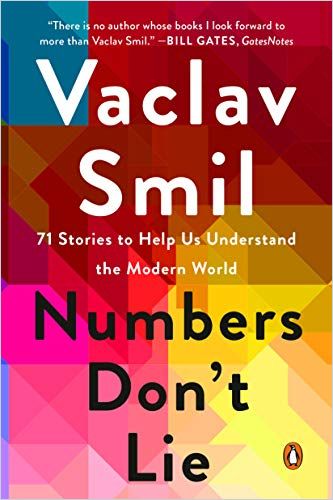Vaclav Smil offers a brief omnibus of his most relevant ideas and insights to paint a clear, unexpected portrait of today’s world.

Smil’s World
Author Vaclav Smil, professor emeritus and fellow of the Royal Society of Canada (Science Academy), offers his greatest hits from past books, served up in short, engaging chapters. This most accessible – by far – of his works will probably sell more than his others combined, especially given Bill Gates’s endorsement. Though it comes recommended, readers should brace for a pessimistic read that borders on the cynical. Smil’s numbers may speak the truth, but he tends to discount humankind’s endless hope and ingenuity.
Bill Gates said that Smil “takes everything that makes his writing great and boils it down into an easy-to-read format. I unabashedly recommend this book to anyone who loves learning.” Publishers Weekly wrote that the author “presents a robust array of data, at times with devastating acuity.” Kirkus found that “even when examining dire circumstances, Smil keeps readers engaged. A fascinating book to be read straight through or consulted bit by bit.”
Life Up; Birth Down
Smil commences by saying that the average woman could give birth to at least 24 children during her nearly 40 years of fertility, but average national birth rates around the world range from fewer than one child per woman to more than seven. He links birth rates map to prosperity: Richer nations have lower birth rates and richer parents choose quality over quantity, pouring more resources into fewer kids. In fact, he adds, your longevity depends entirely on your nation’s prosperity.
No country has been able to stop the fertility decline at the replacement level and achieve a stationary population.Vaclav Smil
Falling populations, the author asserts, bring negative social, geopolitical and economic consequences wherever the decline manifests.
Work
Smil loves random factoids with no practical applications that somehow forever change your perspective. For example, he details how ancient human hunter-gatherers ran deer and faster prey to exhaustion. Therefore, he says, they didn’t need weapons because they could chase down an antelope in an afternoon.
The author reports that the Greek historian Herodotus estimated the labor force that build Egypt’s Great Pyramid at hundreds of thousands. However, Smil reports, the total number of workers was probably fewer than 10,000 – an estimate based on modern knowledge of the ratio of caloric intake to work output and on excavations of housing and burial artifacts that enabled historians to calculate the size of the labor force.
Smil repeats a homily that appears in many contemporary works: Work brings money, but money doesn’t guarantee happiness. The United States boasts one of the world’s richest populations but barely cracks the top 20 happiest nations. Ecuador tops Kuwait, and Colombia beats Japan. Smil explains that little separates the happiest nations from one another, and the measurements defy easy explanation – especially since violent, unstable and poor Catholic countries outrank safe, stable, rich and secular nations.
Rise and Fall
Smil notes that while America contributed enormously to World War I and World War II Allied victories, and the United States defeated the Soviet Union in the space race and the Cold War, it hasn’t won a shooting war in 75 years. The idea of American exceptionalism lives on, but – in comparison with other wealthy nations – the United States has a high infant mortality rate, low life expectancy, poor health and relatively low happiness. Meanwhile, Smil says, Europe has performed miraculously since World War II, marking 75 years of economic growth, peace and the formation of a successful economic union. In his analysis, Britain may have erred in leaving the European Union, given its aging population, reliance on trade and dwindling global relevance.
The author relates that although Japan rose quickly after World War II, it declined just as swiftly. Though China is the world’s largest economy and may soon surpass the United States in real GDP, Smil finds that its people remain poor by rich-nation standards. He points out that the ratio of economically active to economically dependent Chinese peaked in 2010, and warns that as this ratio declines, so will China. Pollution, reliance on foreign fossil fuels and an aging population put China on a path not unlike Japan’s.
Invention and Innovation
Demonstrating his affection for a counterintuitive argument, Smil calls the 1880s the most inventive period in history, and explains how its applied electricity, streetcars, bicycles and elevators shape lives today. He notes, however, that many predicted products have failed to materialize: Autonomous cars, personalized cancer cures, 3D printed organs and renewable power sources remain elusive.
Why do we not improve the boarding of planes rather than delude ourselves with visions of hyperloop trains and eternal life?Vaclav Smil
He argues forcefully that people waste time obsessing over fanciful futuristic visions and spend too little time improving crucial existing challenges.
Renewables
Wind and solar power, Smil reports, face scaling problems due to wind’s enormous footprint demands and solar’s land requirements.
In absolute terms, the world has been running into – not away from – carbon.Vaclav Smil
He depicts how equally clean hydroelectricity generates about eight times more power than solar worldwide and cautions readers that manufacturing and implementing wind and solar power requires expending enormous amounts of fossil fuels.
Planes, Trains and Automobiles
Smil marvels that an Atlantic steamship crossing took almost a month in the 1880s, but in 1952, the SS United States did it in three and a half days, and the 1970s Concorde crossed the Atlantic in 3.5 hours. He predicts hypersonic planes may cut that crossing to 60 minutes.
Smil breaks down how the production of electric vehicles, their required energy supply and manufacturing materials, plus the general infrastructure of roads and dams, demand vast quantities of fossil fuels. The author underscores that EVs’ plug-in power – for now – comes from gas and coal-fired electricity.
Unsustainable
In one example of how Smil contrasts pluses and minuses, he notes that artificially created ammonia and synthetic nitrogen fertilizers enabled increases in food production that fueled a global population rise to eight billion even as nitrates pollute lakes and oceans and contribute to greenhouse gases.
Without synthetic nitrogen fertilizers, we could not secure enough food for the prevailing diets of just over three billion people.Vaclav Smil
He laments that one-third of all food globally goes to waste and that 60% of crops feed animals slaughtered to produce the meat that the world consumes in excess of health guidelines. Many aspects of modern life dishearten Smil, but food waste and its attendant pollution inspire his heartfelt anger.
A Bitter Smile
Smil’s distanced, cynical, classically Mitteleuropean sense of the absurd will make you smile bitter smiles and chuckle knowingly, though, like him, you will reach the end of this short collection with no new solutions for the issues he raises. That’s the problem with accurate, fact-based overviews free of ideological cant or leanings: They’re too pragmatic and realistic to be inspiring. However, Smil is always fun to read, brilliant, never patronizing and consistently illuminating. His research-based rigor renders a lot of pie-in-the-sky futurism obsolete and unnecessary.
Vaclav Smil also wrote, among other books, Grand Transitions, Growth, and Energy and Civilization.





